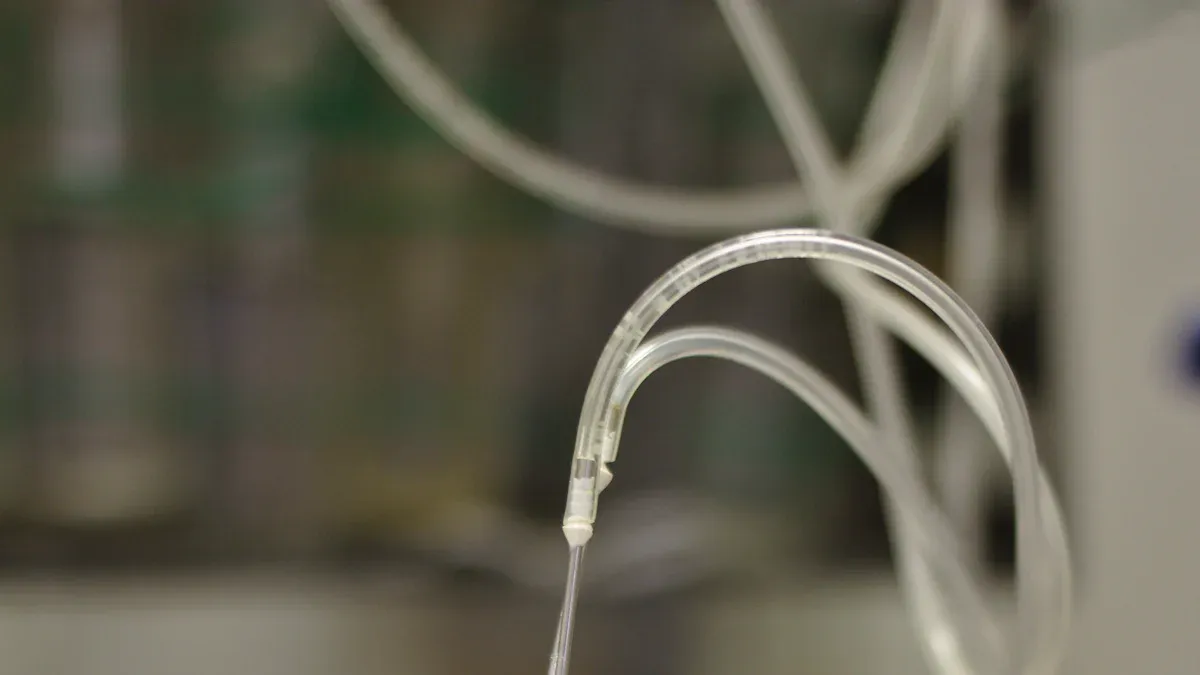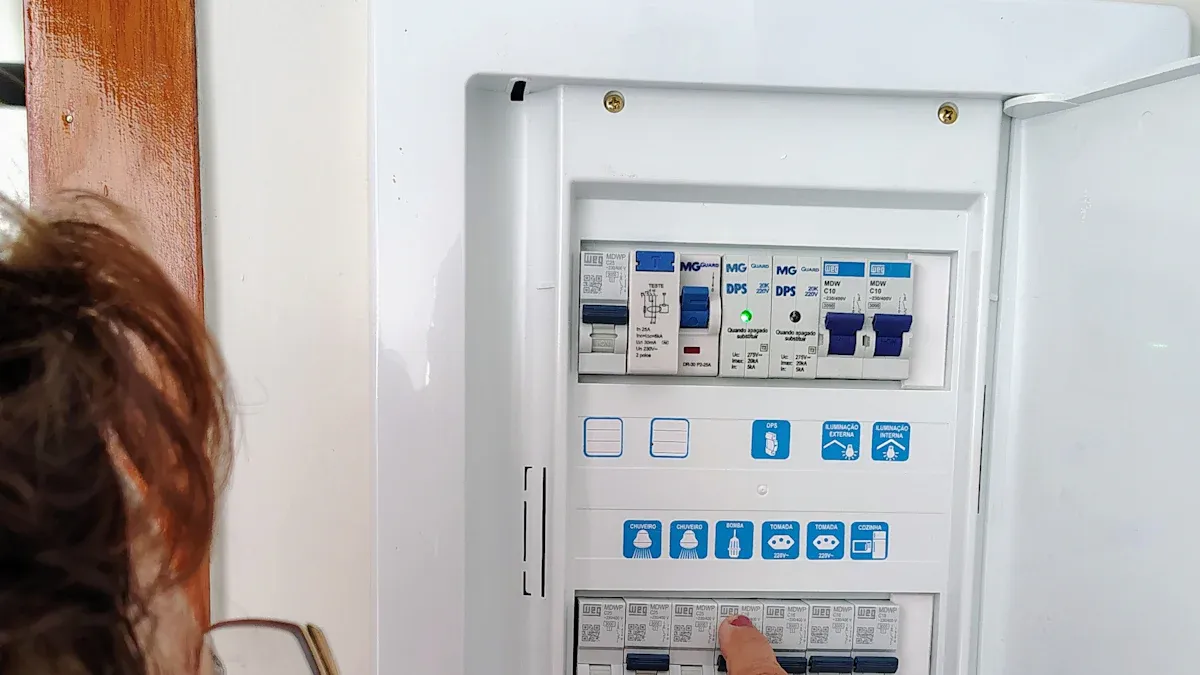How Nitinol Thrombectomy Stent Saves Stroke Lives

Nitinol thrombectomy stents have revolutionized the treatment of stroke by enabling precise and swift removal of blood clots. Their ability to restore blood flow to the brain reduces the risk of long-term damage. Clinical studies highlight their effectiveness. For instance:
The SARIS study showed 100% of patients achieved TIMI 2/3 blood flow.
Only 5% experienced symptomatic intracranial hemorrhage.
Over half of the patients had favorable recovery outcomes with a modified Rankin Scale score of ≤ 2.
These outcomes underscore the life-saving potential of Nitinol Thrombectomy Stent for Stroke Treatment.
Key Takeaways
Nitinol stents quickly remove blood clots, helping stroke patients survive.
These stents are flexible and can fit tricky blood vessels easily.
Studies show over half of patients recover well after using them.
Their design lowers the chance of problems and protects blood vessels.
Using Nitinol stents early saves brain function and helps recovery.
Understanding Nitinol Thrombectomy Stents

Unique properties of Nitinol: Shape-memory and flexibility
Nitinol stands out due to its remarkable shape-memory effect and flexibility. These properties make it an ideal material for medical devices like thrombectomy stents. The shape-memory effect allows Nitinol to return to its original shape after deformation. This transformation occurs due to a solid-state phase change between cubic austenite and monoclinic martensite phases.
Flexibility is another key feature. Nitinol exhibits tension–compression asymmetry, enabling it to handle larger tension strains under smaller stresses. This characteristic ensures the stent can adapt to the intricate and delicate structure of blood vessels during stroke treatment.
Property | Description |
|---|---|
Shape-Memory Effect | Nitinol undergoes a solid-state transformation between cubic austenite and monoclinic martensite phases, enabling it to return to a predetermined shape when heated. |
Flexibility | Exhibits greater tension–compression asymmetry, allowing for more transformation strain at lower transformation stresses in tension compared to texture-free material. |
Tension Strain | Larger tension strains are observed under smaller stresses, mimicking trends shown by single-crystal mechanics calculations. |
Design features for effective clot removal
The design of Nitinol thrombectomy stents enhances their ability to remove clots efficiently. These stents possess mechanical properties such as optimal radial force, flexibility, and robust recapture force. Structural performance studies show promising thrombus retrieval rates, making them comparable to existing products.
Micro-patterns on the stent's surface further improve clot retrieval. These patterns increase the device's grip on the thrombus, ensuring effective removal during mechanical thrombectomy procedures. In vitro experiments confirm that these micro-patterns enhance the stent's efficacy in blood clot retrieval.
Micro-patterns on the surface of Nitinol stent retrievers enhance the effectiveness of mechanical thrombectomy.
In vitro experiments showed improved efficacy in blood clot retrieval due to these micro-patterns.
Why Nitinol is ideal for stroke treatment
Nitinol's unique properties make it the preferred material for stroke treatment. Its self-expanding capabilities allow stents to adapt to various lesion types, ensuring effective clot removal. The material's flexibility enhances performance during carotid artery stenting, a critical procedure for stroke patients.
Additionally, Nitinol stents provide high scaffolding and predictable radial force. These features maintain vessel integrity during and after deployment, reducing the risk of complications. Compared to other materials, Nitinol offers superior adaptability and reliability, making it indispensable in modern stroke care.
Nitinol stents have self-expanding capabilities that allow them to adapt to various lesion types effectively.
The material's flexibility enhances its performance in carotid artery stenting (CAS) for stroke treatment.
Nitinol stents provide high scaffolding and predictable radial force, which are crucial for maintaining vessel integrity during and after deployment.
The Role of Nitinol Stents in Mechanical Thrombectomy
How mechanical thrombectomy devices work
Mechanical thrombectomy devices have transformed stroke care by enabling the removal of blood clots from blocked arteries. These devices, including nitinol stent retrievers, are designed to restore blood flow quickly and effectively. The process begins with the insertion of a guidewire into the affected artery. This guidewire helps navigate the device to the site of the clot. Once positioned, the stent retriever expands to capture the clot, allowing it to be removed from the vessel.
Nitinol plays a critical role in this process. Its shape-memory properties ensure that the stent retriever can expand and conform to the vessel's shape, even in complex anatomies. This adaptability minimizes the risk of vessel damage during the procedure. The flexibility of nitinol also allows the device to navigate through tortuous blood vessels, making it ideal for mechanical thrombectomy.
The process of using Nitinol stents for clot removal
The step-by-step process of using nitinol stent retrievers in mechanical thrombectomy is both precise and efficient. The following steps outline the procedure:
Insert a standard 0.014” coronary guidewire distal to the occlusion or thrombotic site.
Position a microcatheter distal to the occlusion using a second guidewire, often referred to as the parallel wire technique.
Deploy the nitinol stent retriever, such as the NeVa MTD, at the thrombus site and insert a guiding catheter extension.
Remove the guiding catheter extension and the stent retriever while keeping the initial guidewire in place for subsequent treatment.
This method ensures successful recanalization by effectively capturing and removing the clot. Studies have shown that nitinol stent retrievers achieve high rates of immediate reperfusion, with success rates ranging from 80% to 90%. These results highlight the efficiency of nitinol-based devices in stroke treatment.
Advantages over traditional stroke treatments
Mechanical thrombectomy devices, particularly those using nitinol stent retrievers, offer several advantages over traditional stroke treatments. Unlike intravenous thrombolysis, which relies on clot-dissolving medications, thrombectomy provides a mechanical solution to physically remove the clot. This approach is especially beneficial for large vessel occlusions, where medication alone may not be effective.
A comparison of mechanical thrombectomy devices with traditional treatments reveals their superior performance. For example:
Device | Complete Recanalization Rate (TICI 3) | Safety Endpoints Comparison | Clinical Outcomes Comparison |
|---|---|---|---|
Solitaire FR | 86.7% | Comparable | Comparable |
Tonbridge Stent | Comparable to Solitaire FR | Comparable | Comparable |
Nitinol stent retrievers also reduce the risk of complications. Their self-expanding design ensures gentle interaction with the vessel walls, minimizing the likelihood of vessel injury. Additionally, the use of advanced imaging techniques, such as intravascular ultrasound (IVUS), enhances the precision of the procedure. This combination of innovative materials and technology makes mechanical thrombectomy a safer and more effective option for stroke patients.
AccuPath, a leading manufacturer of nitinol tubing, plays a vital role in the development of these life-saving devices. Their high-quality nitinol tubing ensures the reliability and performance of stent retrievers, contributing to better outcomes in stroke care.
Benefits of Nitinol Stents in the Treatment of Stroke
Faster and more efficient clot removal
Nitinol stents significantly enhance thrombectomy efficiency by enabling faster and more precise clot removal. Their shape-memory properties allow them to expand and conform to the vessel's shape, ensuring optimal engagement with the clot. This adaptability reduces the time required for the procedure, which is critical in stroke treatment. Studies have shown that nitinol-based thrombectomy devices achieve high rates of immediate reperfusion, often exceeding 80%. This rapid restoration of blood flow minimizes the risk of further brain damage, improving patient outcomes.
AccuPath, a leading manufacturer of nitinol tubing, plays a pivotal role in the development of these advanced devices. Their high-quality nitinol tubing ensures the reliability and performance of stent retrievers, contributing to the overall thrombectomy efficacy.
Reduced brain damage and improved recovery
The use of nitinol stents in thrombectomy procedures helps reduce brain damage by restoring blood flow quickly. When blood flow is blocked during a stroke, brain cells begin to die within minutes. Nitinol stents, with their superior thrombectomy efficiency, ensure that clots are removed swiftly, limiting the extent of brain damage. This rapid intervention leads to better recovery outcomes for patients. Clinical data supports this, showing that over 50% of patients treated with nitinol stents achieve favorable recovery outcomes, as measured by the modified Rankin Scale.
The flexibility of nitinol also allows these devices to navigate complex blood vessel anatomies without causing additional trauma. This feature further enhances recovery by minimizing procedural complications.
Lower risk of complications during treatment
Nitinol stents reduce the risk of complications during stroke treatment due to their unique material properties. Their self-expanding design ensures gentle interaction with vessel walls, minimizing the likelihood of vessel injury. Additionally, drug-eluting nitinol stents have demonstrated lower restenosis rates compared to bare-metal stents. For example:
A 2019 meta-analysis reported a restenosis rate of only 4.1% in patients treated with drug-eluting stents.
A randomized controlled trial in 2022 showed significantly reduced restenosis rates (p<0.001) and lower ischemic stroke recurrence rates (p<0.03) in patients receiving drug-eluting stents.
These findings highlight the safety and effectiveness of nitinol stents in thrombectomy procedures. AccuPath's precision-engineered nitinol tubing ensures that these devices meet the highest standards of quality and performance, further reducing the risk of complications.
Impact of Nitinol Stents on Stroke Outcomes

Improved survival rates in ischemic stroke
Nitinol stents have significantly improved survival rates for patients experiencing acute ischemic stroke. These devices enable rapid recanalization of blocked arteries, restoring blood flow to the brain. This process minimizes the extent of cerebral damage caused by oxygen deprivation. Studies have shown that patients treated with nitinol-based thrombectomy devices achieve higher survival rates compared to those receiving traditional treatments.
The ability of nitinol stents to adapt to the complex anatomy of cerebral vessels ensures effective clot removal. This adaptability reduces the time required for recanalization, which is critical in stroke care. Faster intervention leads to better outcomes, as brain cells begin to die within minutes of a blockage. By removing thrombi efficiently, nitinol stents play a vital role in saving lives and improving recovery prospects for stroke patients.
Clinical success stories and supporting data
Clinical evidence highlights the effectiveness of nitinol stents in treating acute ischemic stroke. For example, a multicenter trial reported that over 85% of patients achieved successful recanalization using nitinol-based thrombectomy devices. These results demonstrate the reliability of nitinol stents in restoring blood flow during thrombus retrieval therapy.
One notable success story involves a patient with acute cerebral infarction who underwent thrombectomy using a nitinol stent. The procedure achieved complete recanalization within 30 minutes, resulting in a full recovery. Such cases underscore the life-saving potential of these devices. Additionally, studies comparing nitinol stents with suction thrombectomy devices have shown that nitinol-based approaches achieve superior clinical outcomes, including reduced infarction size and improved neurological recovery.
The data also reveals that nitinol stents reduce the risk of complications during stroke treatment. Their self-expanding design minimizes vessel injury, ensuring safer procedures. These findings provide strong evidence for the widespread adoption of nitinol stents in modern stroke care.
Importance of early intervention in stroke care
Early intervention is crucial in the treatment of acute ischemic stroke. The use of nitinol stents for thrombectomy allows for rapid recanalization, which is essential for preserving brain function. Delayed treatment increases the risk of severe cerebral damage and poor outcomes. Therefore, timely access to thrombectomy devices can make a significant difference in patient recovery.
Healthcare providers emphasize the importance of recognizing stroke symptoms and seeking immediate medical attention. Symptoms such as sudden weakness, difficulty speaking, or loss of vision should prompt urgent action. Hospitals equipped with advanced thrombectomy devices, including nitinol stents, can provide life-saving care within the critical time window.
Public awareness campaigns also play a role in improving stroke outcomes. Educating communities about the benefits of early intervention and the availability of advanced treatments like nitinol stents can help reduce the burden of stroke-related disabilities. By prioritizing early care, healthcare systems can enhance survival rates and improve the quality of life for stroke survivors.
Future Innovations in Mechanical Thrombectomy Devices
Advancements in Nitinol stent technology
Recent advancements in nitinol stent technology have significantly enhanced their efficacy in mechanical thrombectomy procedures. Engineers and researchers have introduced self-expanding nitinol stents that utilize the material's superelastic properties. These stents adapt seamlessly to vessel walls, ensuring better performance in complex vascular anatomies. Additionally, fracture-resistant designs now improve durability, addressing limitations seen in earlier braided models.
Laser-cut designs represent another breakthrough. These stents offer longer lengths and precise placement, which are essential for treating extensive venous obstructions. Modern nitinol stents can now reach lengths of up to 160 mm, making them suitable for larger lesions. Furthermore, innovations such as drug-eluting stents release medication to prevent restenosis, expanding their use in challenging cases.
Advancement | Description |
|---|---|
Self-expanding Nitinol Stents | Utilize superelastic properties for enhanced performance in venous applications. |
Fracture Resistance | Provide improved durability compared to earlier braided designs. |
Laser-cut Designs | Enable longer stent lengths and precise placement for complex obstructions. |
Drug-Eluting Stents | Release medication to reduce restenosis and improve outcomes in complex cases. |
Expanding global access to thrombectomy procedures
Expanding access to thrombectomy procedures remains a critical goal in stroke care. Many regions, particularly in low- and middle-income countries, lack the infrastructure and expertise needed for these life-saving interventions. Addressing this gap requires a multifaceted approach. Governments and healthcare organizations must invest in training programs for medical professionals. These programs should focus on the safe and effective use of nitinol-based devices.
Affordable manufacturing solutions can also play a role in increasing access. By reducing production costs, manufacturers can make nitinol stents more accessible to underserved populations. Partnerships between global health organizations and device manufacturers could further facilitate the distribution of these advanced tools. Public awareness campaigns highlighting the efficacy of thrombectomy procedures may encourage early intervention, ultimately improving outcomes for stroke patients worldwide.
Potential applications in other vascular conditions
The unique properties of nitinol stents open doors to applications beyond stroke treatment. Their superelasticity and shape-memory capabilities make them ideal for addressing other vascular conditions. For example, nitinol stents are increasingly used in treating peripheral artery disease (PAD). These stents conform to the vessel's shape, reducing the risk of restenosis and improving long-term efficacy.
Nitinol's biocompatibility also makes it suitable for use in coronary artery disease. Drug-eluting nitinol stents have shown promise in preventing restenosis in coronary arteries, offering a reliable solution for patients with complex lesions. Additionally, researchers are exploring the use of nitinol stents in venous thromboembolism and other vascular disorders. These advancements highlight the material's versatility and its potential to revolutionize vascular care.
Nitinol thrombectomy stents have transformed stroke treatment by enabling rapid clot removal and improving survival rates. Their shape-memory and flexibility ensure precise performance during procedures, making them indispensable in modern stroke care. Comparative studies highlight their advantages, such as lower restenosis rates and higher clinical outcomes.
Group | Median Total COF (N) | Restenosis Rate | P-Value |
|---|---|---|---|
High COF | 55.69 | Higher | < .001 |
Low COF | 14.89 | Lower |
As technology advances, these stents will continue to save lives and redefine stroke care worldwide. Their role in improving patient outcomes remains critical in the fight against stroke-related disabilities.
FAQ
What makes nitinol thrombectomy stents unique for stroke treatment?
Nitinol thrombectomy stents possess shape-memory and flexibility. These properties allow them to adapt to blood vessel anatomy and effectively remove thrombus during thrombectomy procedures. Their self-expanding design ensures precise clot engagement and minimizes vessel injury.
How do nitinol stents improve stroke outcomes?
Nitinol stents restore blood flow quickly by removing thrombus efficiently. This rapid intervention reduces brain damage and improves recovery rates. Their adaptability to complex vessel structures ensures safer procedures and better survival rates for stroke patients.
Are nitinol stents used in other vascular conditions?
Yes, nitinol stents are versatile. They treat peripheral artery disease and coronary artery disease. Their drug-eluting variants prevent restenosis, making them effective for complex vascular conditions beyond stroke treatment.
Why is early intervention critical in stroke care?
Early intervention prevents extensive brain damage. Nitinol thrombectomy stents for stroke treatment enable rapid clot removal, preserving brain function. Recognizing stroke symptoms and seeking immediate medical attention can save lives.
What advancements are expected in nitinol stent technology?
Future innovations include fracture-resistant designs, longer laser-cut stents, and drug-eluting models. These advancements will enhance performance, durability, and efficacy in thrombectomy and other vascular applications.
See Also
Nitinol Tubing's Impact on Modern Medical Innovations
The Importance of Nitinol Tubing in Minimally Invasive Surgery
Nitinol Tubing: A Game Changer for Medical Equipment

